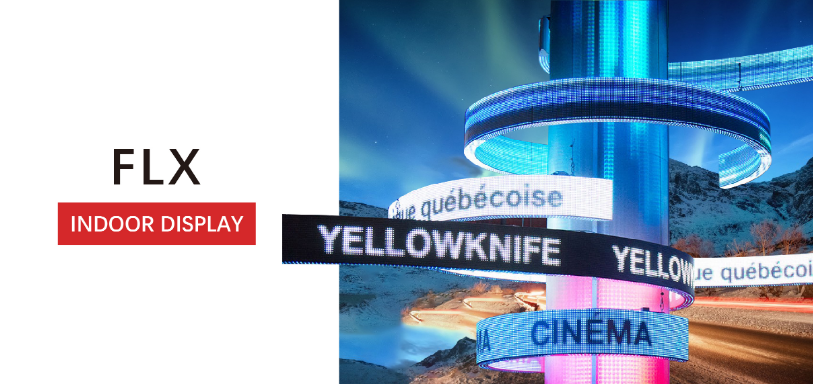Creative LED Displays: Possibilities and Inspirations
LED displays have undergone a remarkable evolution since their inception as basic scoreboards and messaging signs. Presently, innovative LED displays are revolutionizing environments and engagements through vibrant visuals, interactive features, and state-of-the-art technology. This article delves into the distinctive traits of creative LED displays, the myriad possibilities they offer, and essential guidelines for crafting compelling LED projects.
What is Creative LED Display?
A creative LED display transcends mere information dissemination by captivating viewers with imaginative visuals and interactive features. Unlike traditional LED signs limited to displaying text, numbers, or basic graphics, creative LEDs leverage:
- Innovative shapes and configurations: They defy convention by assuming various forms like waves, spheres, or unique grids, moving beyond conventional rectangular screens.
- Dynamic motion and effects: Advanced LEDs showcase moving imagery, seamless transitions, and multimedia content, incorporating animation, video, and special effects.
- Interactivity: Modern LEDs engage viewers by adapting content based on sound, motion, or touch inputs, fostering an immersive and personalized experience.
- Generative and real-time content: LEDs exhibit generative content, such as simulated water ripples, dynamically generated by software in real-time, enabling evolving and responsive displays.
The primary objective is to craft captivating and artistic visuals that captivate attention and forge connections with audiences. Creative LEDs are chosen when the display itself warrants being a central and artistic focal point.
Traditional LED signs are constrained by their inherent limitations:
- Basic designs: Typically, they utilize simplistic rectangular screens for showcasing text and numbers.
- Static content: These displays merely present pre-programmed or streamed messages and graphics, lacking dynamic movement or variation.
- Limited color range: Early iterations of LEDs were restricted to a single color, predominantly red, with later versions offering basic multi-color options.
- Lower resolution: Traditional LEDs are characterized by lower pixel density, resulting in diminished image quality.
- Absence of interactivity: These displays lack the ability to dynamically respond to or engage with viewers.
In contrast, creative LED displays offer an expansive array of possibilities owing to their advanced technical capabilities and emphasis on artistic expression. The only constraints lie within the confines of the designer's imagination and budget.
Categories of Creative LED Displays
Creative LED displays are categorized based on their capabilities and interactivity, encompassing:
Generative LEDs
These displays generate ever-evolving, software-driven visuals such as rippling water, swirling particles, or blooming flowers. The content continuously evolves in real-time, ensuring each display is unique.
Interactive LEDs
Interactive LED wallsrespond to human activity, including motion, touch, or sound. The content dynamically changes based on the audience's movements or sounds, creating an immersive and interactive experience.
3D Volumetric LEDs
Volumetric LEDs employ LED pixels arranged in three-dimensional shapes to create 3D imagery that appears to float in midair, providing a hologram-like visual experience.
Flexible and Transparent LEDs
Utilizing advanced materials, flexible LED screens can bend around structures or hang like fabric, while transparent LEDs can overlay visuals on real-world objects behind them, offering innovative display solutions.
Multimedia LEDs
High-resolution LED walls seamlessly integrate and display multimedia content such as videos, animations, graphics, and websites, enabling the creation of intricate, large-scale visuals for entertainment or storytelling purposes.
Innovative Applications of LED Displays
Creative LED displays unlock groundbreaking experiences across diverse industries and venues:
Retail - Interactive LEDs draw in shoppers, while generative LEDs set the ambiance and energize spaces. Window LEDs serve as captivating displays to entice passersby.
Events - LED stages, interactive floors, and volumetric LEDs offer immersive experiences at concerts, festivals, and corporate events, enhancing audience interaction.
Architecture - LED media facades transform buildings into dynamic canvases for showcasing generative art or conveying informational displays, enriching urban environments.
Museums - Creative LEDs elevate storytelling through interactive exhibits and multimedia imagery, fostering deeper visitor engagement and comprehension.
Brand experiences - 3D volumetric LEDs create impactful branded photo opportunities, while LED floors and projections deliver shareable moments, amplifying brand exposure and engagement.
Science and engineering - Transparent and flexible LEDs enable interactive simulations of phenomena like weather maps and molecular structures, facilitating immersive educational experiences.
The possibilities are limitless - if it can be displayed digitally, it can be realized through a creatively engineered LED installation.
Tips for Designing Innovative LED Displays
Expand beyond conventional screens by opting for imaginative physical forms such as spheres, tunnels, and irregular shapes.
- Integrate interactivity using sensors, cameras, and multi-touch capabilities to respond to sound, motion, and gestures.
- Utilize generative content to create evolving, nature-inspired visuals that transform over time, enhancing viewer engagement.
- Experiment with multi-angle and 3D designs to introduce depth, and layer transparent LED panels for added dimensionality.
- Tailor content and animations to suit the LED wall's size, shape, and resolution, ensuring optimal visual impact.
- Design the LED wall with accessibility, maintenance, and future upgrades in mind, ensuring seamless operation as technology advances.
- Consider how lighting, materials, and surrounding elements influence the overall visual experience, enhancing cohesion and immersion.
By employing thoughtful planning, engineering, and design principles, creative LED displays can deliver breathtaking and shareable viewer experiences that inspire and captivate audiences in unprecedented ways. The future of LED innovations holds limitless possibilities.









Leave a comment